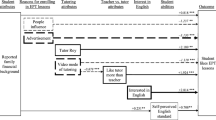Abstract
To recognize captioning benefits as a part of Universal Design, the study proposed to identify captioning benefits of American students who are native speakers, American students who are English as second language learners, International students, and deaf and hard of hearing students from two California universities. This study used the contingent valuation method, specifically, willingness to pay for survey design. Imagining if a university offers a captioned online course, the four groups were asked what factors they would be willing to pay for captioned online courses. American students and International students would be willing to pay for a variety of reasons, such as academic achievement, environmental convenience, and accessibility. Captioning benefits were not limited to deaf and hard of hearing students for accommodations, but also to American students and International students. The results could be a possibility of expanding future captioned online courses at universities as part of a Universal Design curriculum.
Similar content being viewed by others
References
Bateman, I.J., Carson, R.T., Day, B., Hanemann, M., Hanley, N., Hett, T., Jones-Lee, M., Loomes, G., Mourato, S., Özdemiroğlu, E., Pearce, D.W., Sugden, R., Swanson, J.: Economic valuation with stated preference techniques: a manual. Edward Elgar, Cheltenham, UK (2002)
Bowe F, Kaufman A (2001) Captioned media: teacher perceptions of potential values for students with no hearing. Captioned Media Program. http://www.dcmp.org/caai/nadh51.pdf
Carson, R.T.: Contingent valuation: a user’s guide. Environ. Sci. Technol. 34(8), 1413–1418 (2000). doi:10.1021/es990728j
Danan, M.: Captioning and subtitling: undervalued language learning strategies. Meta: Transl. J. 49(1), 67–77 (2004). doi:10.7202/009021ar
Greene, W.: LIMDEP: Econometric modeling guide (Version 9.0). Software. Plainview, NY. Econometric Software, Inc (2007)
Holmes, K.P., Rutledge, S., Gauthier, L.R.: Understanding the cultural-linguistic divide in American classrooms: language learning strategies for a diverse student population. Read. Horiz. 49(4), 285–300 (2009)
Huang, H., Eskey, D.: The effects of closed captioned television on the listening comprehension of intermediate English as a second language (ESL) students. J. Educ. Technol. Syst. 28(1), 75–96 (1999). doi:10.2190/RG06-LYWB-216Y-R27G
Lewis, M.S.J., Jackson, D.W.: Television literacy: comprehension of program content using closed captions for the deaf. J. Deaf Stud. Deaf Educ. 6(1), 43–53 (2001). doi:10.1093/deafed/6.1.43
Markham, P.L., Peter, L.A., McCarthy, T.J.: The effects of native language vs. target language captions on foreign language captions on foreign language students’ DVD video comprehension. Foreign Lang. Ann. 34(5), 439–445 (2001). doi:10.1111/j.1944-9720.2001.tb02083.x
Mitchell, R., Carson, R.: Using surveys to value public goods: the contingent valuation method. Resources for the Future, Washington, DC (1989)
Office of Disability Employment Policy: Employers and the ADA: myths and facts (n.d.). http://www.dol.gov/odep/pubs/fact/ada.htm
Qualtrics: Software (2015). http://www.qualtrics.com/
Rowland, J.L.: Closed-captioned video and the ESL classroom: a multi-sensory approach. J. Adult Educ. 36(2), 35–39 (2007)
Udo, J., Fels, D.: The rogue poster-children of Universal Design: closed captioning and audio description. J. Eng. Des. 21(2–3), 207–221 (2010). doi:10.1080/09544820903310691
U.S. Department of Education: Assistive technology sections 504 and 508 of the rehabilitation act of 1973 (2013). http://www2.ed.gov/policy/gen/guid/assistivetech.html
Zanon, N.T.: Using subtitles to enhance foreign language learning. Porta Linguarum 6, 41–52 (2006). http://www.ugr.es/~portalin/articulos/PL_numero6/talavan.pdf
Author information
Authors and Affiliations
Corresponding author
Rights and permissions
About this article
Cite this article
Yabe, M. Benefit factors: American students, International students, and deaf/hard of hearing students’ willingness to pay for captioned online courses. Univ Access Inf Soc 15, 773–780 (2016). https://doi.org/10.1007/s10209-015-0424-1
Published:
Issue Date:
DOI: https://doi.org/10.1007/s10209-015-0424-1




